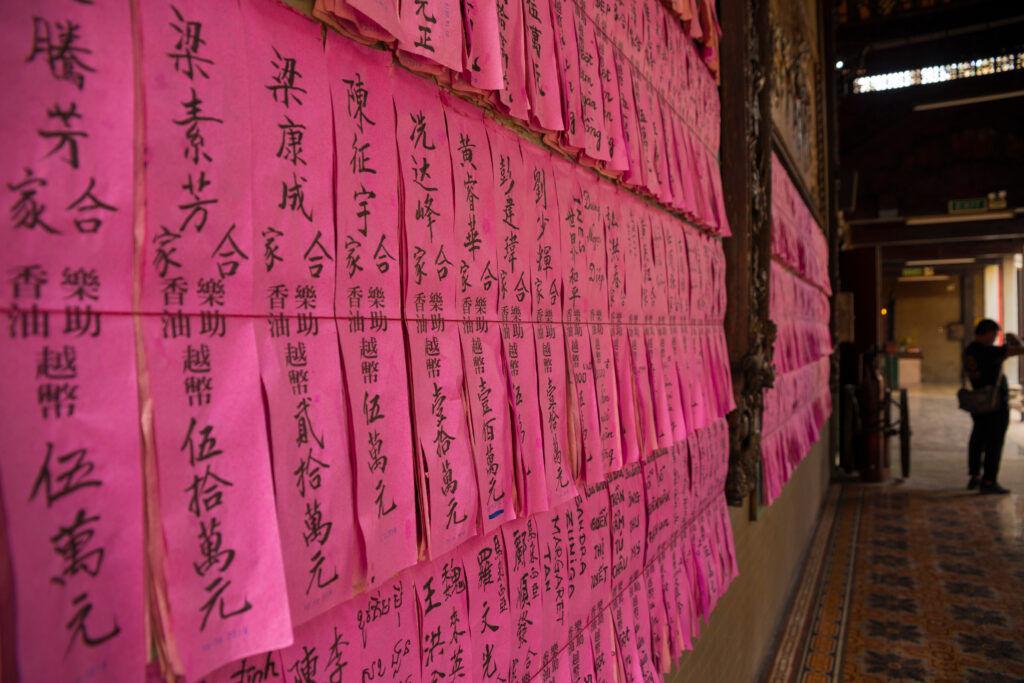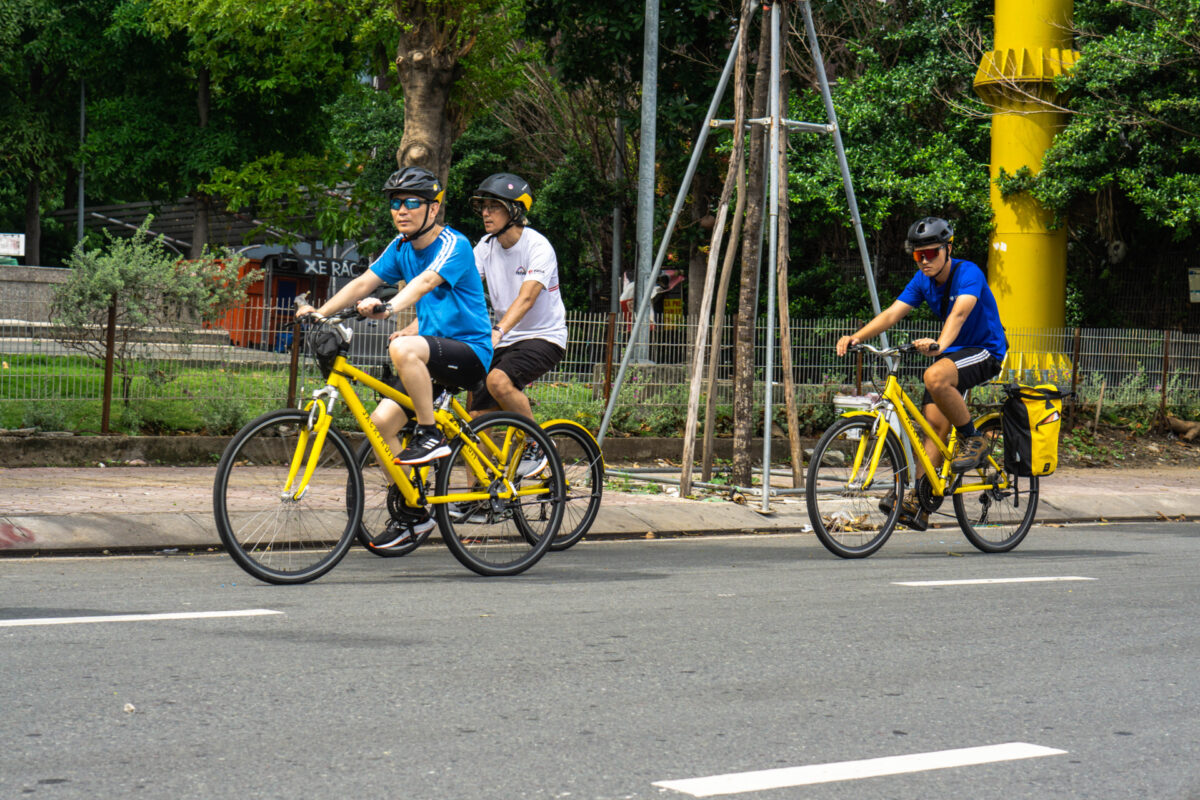
Tucked away in the vibrant heart of Ho Chi Minh City’s Chinatown (Cho Lon), Ba Thien Hau Pagoda stands as one of the most revered and historic Chinese temples in the city. This 200-year-old temple, rich in cultural and spiritual significance, offers visitors a glimpse into the enduring legacy of the Chinese-Vietnamese community in Vietnam. As one of the oldest temples in Ho Chi Minh City, it attracts countless locals and travelers alike, seeking both spiritual solace and cultural insights.
Ba Thien Hau Pagoda is more than just a glimpse into the past—it offers a deep connection to the spiritual life of the local Chinese community. Whether you’re a traveler seeking cultural insights, a history enthusiast, or a spiritual seeker looking for quiet reflection, Ba Thien Hau Pagoda promises a meaningful experience.
How to Get to Ba Thien Hau Pagoda

Ba Thien Hau Pagoda is located at 710 Nguyen Trai Street, Ward 11, District 5, in the bustling Chinatown area of Ho Chi Minh City.
The easiest way to reach the pagoda from District 1 is by taxi, which costs between 50,000 to 100,000 VND depending on traffic. The distance is around 5 kilometers, and the ride typically takes 15 to 20 minutes. For a more eco-friendly option, Ho Chi Minh cycling tour through District 5 is a fantastic way to explore the area. The lively streets make for an engaging ride, offering a chance to experience Chinatown in a unique and active way.
For those who prefer a more guided experience, our Trails of Quach Dam: Chinatown Discovery or Saigon-off-the-beaten path offers an immersive journey through the hidden gems of Cho Lon, including story about the richest man in Cholon Saigon, lesser-known temples, bustling markets, and traditional shops.
Best Time to Visit and Insider Tips

Ba Thien Hau Pagoda is open daily from 6:00 AM to 5:30 PM, but for a quieter, more reflective visit, it’s recommended to arrive early in the morning. The morning light enhances the temple’s serene atmosphere, allowing visitors to experience the pagoda without the hustle and bustle of larger crowds.
As with most temples in Vietnam, it’s important to dress modestly when visiting Ba Thien Hau Pagoda. Ensure your shoulders and knees are covered as a sign of respect. While inside the temple, feel free to light incense, but be mindful of others who are praying. Photography is usually allowed, but avoid taking photos of people in prayer without their permission
The History and Legends of Ba Thien Hau Pagoda

Ba Thien Hau Pagoda, also known as Thien Hau Temple, is dedicated to Thien Hau Thanh Mau, the Lady of the Sea, a deity revered by many Chinese communities. Her story is one of remarkable bravery, wisdom, and spiritual power. According to legend, Thien Hau was born in Fujian, China, in 1044 and was known for her supernatural ability to predict weather patterns, protect sailors, and ensure safe voyages for fishermen.
One of the most famous legends tells of Thien Hau’s spiritual journey to rescue her family from a storm at sea. While physically weaving fabric beside her mother, Thien Hau’s spirit ventured to the open waters, where she saved her brothers from the crashing waves. Sadly, she could not save her father, but her bravery solidified her status as a deity, especially among maritime communities.
When Chinese immigrants settled in Cho Lon, Saigon’s bustling Chinatown, they brought their devotion to Thien Hau with them. The temple was constructed in her honor in the 17th century, and since then, it has been a cornerstone of spiritual life for the Chinese-Vietnamese community. Over the centuries, Ba Thien Hau Pagoda has evolved from a simple place of worship to a vibrant cultural and spiritual hub, reflecting the deep-rooted traditions and religious practices of the Chinese in the region.
Architecture and Highlights of Ba Thien Hau Pagoda

Ba Thien Hau Pagoda is a masterpiece of architectural design, blending both Chinese and Vietnamese influences. Built using imported materials from China, every inch of the structure tells a story of skilled craftsmanship from the past. The pagoda follows the “seal” architectural style, where interconnected halls form a shape reminiscent of Chinese characters, symbolizing protection, unity, and devotion.
Entrance Gate: As you approach the temple, you’ll be greeted by a green-painted gate adorned with intricate carvings, setting the tone for what lies beyond—a place rich with spiritual significance and artistry.

Front Hall: Upon entering the pagoda, the Front Hall welcomes visitors with altars dedicated to deities such as Phuc Duc Chanh and Mon Quan Vuong Ta. The hall is filled with large paintings and stelae that depict the legendary feats of Thien Hau. This hall is a serene space filled with the scent of burning incense, providing a glimpse into the deep devotion of the people who worship here.

Central Hall: Moving into the temple, the Central Hall showcases the beautiful Phat Lan set, cast in 1886. The hall also houses an ancient palanquin and a gilded dragon boat, both of which are used during religious processions. It’s a quiet, reflective space where visitors can pause for spiritual contemplation.

Back Hall (Main Hall): The heart of the pagoda is the Main Hall, where the statue of Thien Hau Thanh Mau is enshrined in an intricately carved black wooden frame. Visitors come here to offer prayers and burn incense, seeking protection and blessings. The Back Hall is also dedicated to Kim Hoa Nuong and Long Mau Nuong, two goddesses who are revered for protecting families and children.

Incense Rings: One of the most iconic sights in Ba Thien Hau Pagoda is the incense rings hanging from the ceiling. These incense coils, with attached ribbons, symbolize the prayers and wishes of worshippers. As the fragrant smoke spirals upwards, it represents the connection between the earthly realm and the divine.

Discovering Chinatown: Exploring Cho Lon Beyond the Pagoda
Binh Tay Market: Binh Tay Market is the vibrant heart of Cho Lon. As you walk through its bustling aisles, you’ll be greeted by the lively chatter of vendors selling everything from fresh produce and textiles to traditional Chinese herbs. This is the place to go if you want to experience Chinatown’s daily life in all its vibrant glory. From local delicacies to unique handicrafts, you’ll find a little bit of everything here.
Cha Tam Church: Just a short stroll from the hustle of the market, Cha Tam Church stands as a peaceful reminder of the unique blend of cultures in this area. This church is a blend of French colonial architecture with Chinese design elements, creating a beautiful fusion that’s truly reflective of Cho Lon’s diverse history. Whether you’re here for a quiet moment of reflection or just admiring the architecture, it’s a fascinating stop on your Chinatown journey. For more information, click here.
Ha Chuong Assembly Hall: This hall is a cultural gem, serving as a place where the Chinese community gathers for events and celebrations. The architecture is stunning, with intricate details that showcase traditional Chinese design. Whether you’re attending a festival or just passing through, it’s a space that radiates history and community. Learn more here.

Phung Hung Market: Phung Hung Market may not be as famous as Binh Tay, but that’s part of its charm. This local market offers a quieter, more authentic shopping experience. Here, you can find everything from fresh groceries to household goods, all while getting a more intimate look at daily life in Chinatown. It’s a great spot if you want to escape the tourist crowds and enjoy a more laid-back market atmosphere. For more, check here.

Explore Calligraphy in Cho Lon: While exploring Cho Lon, you’ll notice beautiful examples of traditional Chinese calligraphy everywhere—from shop signs to scrolls hanging in homes. If you’re interested in this art form, you can find studios where skilled calligraphers create intricate pieces using age-old techniques. It’s a beautiful way to experience a living tradition that connects words with deeper meanings. Find out more here.
Try Racket Coffee: For a truly unique taste of Chinatown, try racket coffee. Brewed using a mesh filter that looks like a badminton racket, this strong, flavorful coffee is unlike any other. Chinatown’s cozy cafes are perfect for relaxing with a cup of this local favorite, and if you have a sweet tooth, don’t forget to ask for condensed milk. It’s a great way to take a break and soak in the neighborhood vibe. Discover more here.
Drink Herbal Tea: In Cho Lon, herbal tea is a daily ritual. You’ll find many small shops offering a wide variety of teas brewed from herbs, flowers, and roots—each known for its health benefits. Whether you’re looking for something to help with digestion or just want to try a refreshing new drink, sitting down with a cup of herbal tea is a great way to experience Chinatown’s traditional health remedies. Learn more here.

If you’re keen on exploring more hidden gems and cultural experiences in the area, check out our related blog 26 Things to Do in Chinatown or 12 must-do tours for even more inspiration.
These experiences are just the beginning of what Cho Lon has to offer. Exploring the vibrant markets, historical landmarks, and unique local customs provides a deep and enriching experience of Ho Chi Minh City’s Chinatown. Whether you’re shopping for traditional goods, sipping tea with locals, or marveling at the stunning architecture, Cho Lon offers a glimpse into the rich cultural tapestry of the Chinese-Vietnamese community.
Cultural Significance of Ba Thien Hau Pagoda

What makes Ba Thien Hau Pagoda more than just a historical landmark is its continued importance in the lives of the local Chinese-Vietnamese community. It’s not just a place to visit but a living sanctuary where locals seek protection, guidance, and blessings. During traditional festivals, such as the Lunar New Year, the pagoda becomes a vibrant hub of activity. Locals offer prayers for health, prosperity, and safety, filling the temple with colorful celebrations and devotion.
Let’s Wrap It Up

Visiting Ba Thien Hau Pagoda offers a unique opportunity to step away from the fast pace of Ho Chi Minh City and immerse yourself in a peaceful, spiritual environment. Whether you are interested in exploring its historical significance or connecting with its cultural roots, this pagoda offers something for everyone.
Ho Chi Minh City Cycling Tour In Ho Chi Minh City (Saigon) – Vietnam

At Jackfruit Adventure, we organize Ho Chi Minh City Cycling Tour and Team Building Ho Chi Minh. With a deep knowledge of Saigon city and local connections, we believe we can give you an awesome bonding time together. Contact us today if you have any requests or questions to prepare a trip for your team to bond in Ho Chi Minh – Vietnam.




